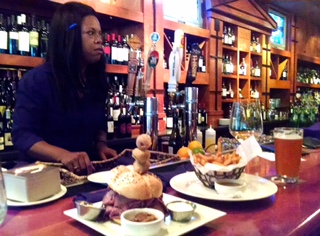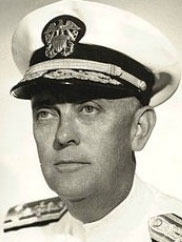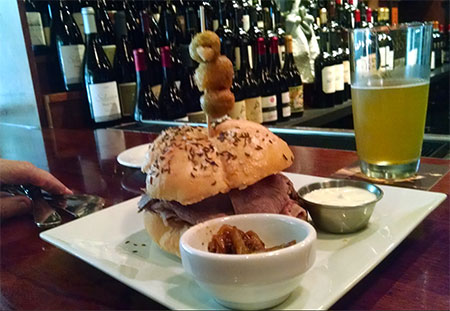
(Boomer behind the bar at the Amen Corner. Photo Socotra).
Willow was bustling, and it was with good reason. The last Friday night of the month was the fabulous Buffalo Night, in which Tracy O’Grady re-creates the most famous sandwich to ever come out of Buffalo, New York: the astonishing ‘Beef on Weck.’
BOW is composed of a slow-cooked locally-raised grass-fed steamer round of beef, thin sliced and piled high on one of Kate Jansen’s amazing Kemmelweck Kaiser rolls, topped with fennel and sea salt. They are so good I normally ordered two in advance to prevent being disappointed when they sold out. I would normally eat one at the bar and take the other one home to snack on the rest of the weekend.
Mac normally dines at The Madison across Fairfax Drive where he lives, but he could sense the excitement as the Regulars filed in and asked Big Jim behind the bar whether the “beef was resting” prior to being carved up into succulent slices.
Mac was dressed in a natty coat and tie, since Buffalo Night we all come straight from the office and look vaguely professional. Boomer was behind the bar, and bantering with the regulars as she normally does in the brassy manner that endeared her to us.
I picked up my pen and slid a stack of napkins over to where I could get at them. “I am afraid we are getting to your return to O’ahu in the early 1960s.”
“Why do you say it that way?” he asked, having a sip of Virgin Mary, since the Doctors were being cruel to him this week.
“Because I am starting to remember some of the events you are describing and it doesn’t seem that long ago,” I said with a laugh.
“You are not going to pin me down like that. I will tell it the way it actually happened, and to do so I have to go back a year before I took the family to Hawaii. It was 1961 when I returned from the senior course at the Naval War College in Newport. After graduating in the summer, I was ordered to ONI again to be the Head of “Y” Branch.”
“Which was the Special Intelligence Division, right?” I asked. “It had become something else by the time I was around.”

(RADM Vernon L. Lowrance as DNI. A World War Two submariner, Lowrance had been awarded the Navy Cross for gallantry. Navy photo).
“Yep. We had a suite in the Pentagon for the various components, not far from Rear Admiral Vernon L. Lowrance’s office as the DNI. Shortly after I arrived and got settled in the building, I had a session with the Admiral in which we discussed my future career. I told him that I would like to branch out of Naval Intelligence to do some things other than pure OPINTEL to broaden myself. I told him I was in a rut and I would like to try something different like an attaché assignment or some other form of Naval Intelligence service.”
“Sounds like fun being a diplomat and open-source intelligence collector going to cocktail parties, but a lot of Attachés got passed over later for being away form the Navy too long.”
“I know, but I was restless. The DNI was sympathetic to my request, but he said “You’re in a rut that an awful lot of people would like to be in with you.” And then he said, “I don’t have a lot of sympathies for your desires to go elsewhere.”
“I told him, if I was to stay in that line of work, that my ultimate desire was to get Eddie Layton’s job as the Intelligence Officer for the Pacific Fleet. That was my desire, and had been ever since the war. My time in Europe and the growing realization of the Soviet Threat never kept me from keeping a fond eye on the activities at CINCPACFLT and who got the jobs as the top Naval Intelligence officer in the Pacific, which was viewed as a job that could be a springboard to selection for Flag. I wanted a shot at it, eventually.”
“You can imagine my surprise when just a few months later, the DNI called me to his office on the fifth Deck and told me he was prepared to send me to CINCPACFLT in the near term if I really wanted to go. I had some misgivings. I only had two years in grade as a Captain, and the job was really for a mid-to-senior officer. I questioned whether I would really be acceptable to the Fleet Commander being that junior, and he assured me “that’s no problem, I’ll take care of that.”
“Always take a challenge” said Mac, as Boomer came by, inspecting the level of liquid in everyone’s glass. “That was my motto, and I told him, “Yes, I’d love to go. So, I agreed, he agreed, and orders were cut to detach from the Pentagon in the summer of 1962 and relocate to Pearl Harbor, where I reported in August.”
“Just in time for the World Series. Didn’t the Yankees beat the San Francisco Giants?”
Mac smiled. “I never had much time to follow baseball, and there is a six hour time difference, remember. It made listening to the games too hard, and who cares about the Yankees, anyway. I had a big job to start. I really was the assistant chief of staff for intelligence when I reported. Three years later I was selected for admiral, and I made my number in December of 1965. That promotion made me the senior Division Chief on the staff for my last six or seven months in the job.”
“How did you feel about that? Your staff during World War II was fighting a global war, was all over the Pacific, and Eddie Layton was about the only Captain that you dealt with. Did you feel that there had been a grade creep out there at that point?”
Mac furrowed his brow. “Well, I think there was a grade creep everywhere. But, I think it was a necessary evil, since Admiral Nimitz had kept his PACFLT staff during the war a very lean organization. The number of officers in the Intelligence Division could practically be counted on the fingers of one hand. But there was the huge organization of JICPOA and the Fleet Radio Unit to back up the Intelligence Division. After those large organizations were done away with in 194l, the intelligence staff itself became larger. And that was true, more or less, of all the divisions on the staff. The staff grew in numbers, because it was an creature unto itself, rather than being supported by a number of subordinate organizations. I don’t remember the numbers in the Intelligence Division, but we must have had 30 or 35 officers in the various sections. It was a large and very busy organization.” Mac paused to wet his whistle and munch on a stalk of celery that stood proudly in his glass.
“Of course, the Vietnam War was just cooking off, and there were many things that had to be done. I mentioned outside organizations that supported us. We did have the Fleet Intelligence Center over on Ford Island to support us, but FICPAC was of relatively little direct support to the staff. FICPAC instead was supporting the fleet, mainly with photography work and with producing targeting materials. Those kinds of things could be produced on a production line basis. What we were doing at the Headquarters, where I was responsible for figuring out what it all meant with analytical work and current reporting and responding to the daily crisis, whatever it was.”
‘
“That hadn’t changed, Sir. Same deal, different year.” I looked at my notes. “The first American casualty of the war was in the 1950s, I said taking a sip of Happy Hour white. “But you were there when things were just starting to get hot. When I worked there, we still had your Vietnam work-week: half day on Wednesdays and they expected a half-day in Saturdays, too.”
“We felt we needed the continuity on the mission and didn’t want to lose details if the analysts were off the whole weekend. We were busy. We were setting up field activities in the Philippines. In hindsight, I think we responded to Fleet requirements one at a time. It was like this In 1961, when I was back in “Y” Branch in Washington. We had commenced a series of peripheral intelligence collection patrols along the Soviet and Chinese coasts known as the DeSoto Patrols.” Ed Nielsen and I originated DeSoto patrols, but I am tired and that is going to have to wait to another session.”
Boomer came down the bar and slid one of the fabulous beef sandwiches in front of me and Mac looked on with interest as she topped off my wine.
“There are other important issues to talk about right now. Do you think the Beef on Weck sandwiches are sold out yet?”

(Willow’s Beef on Weck comes on that fabulous kaiser-style Kemmelweck roll, pierced by a garnish of three deep-fried olives, a side of caramelized onions and Tracy O’Grady’s traditional creamy horseradish sauce. The one I take home can make three or four lunches).
Copyright 2017 Vic Socotra
www.vicsocotra.com
